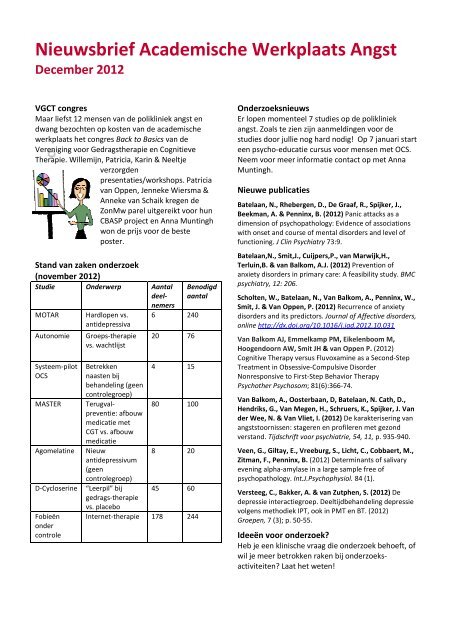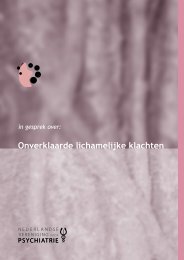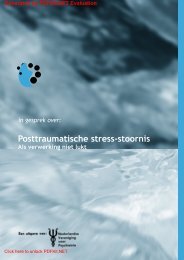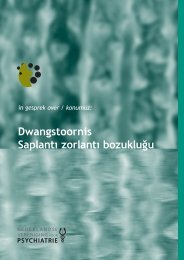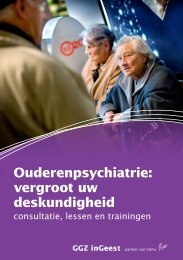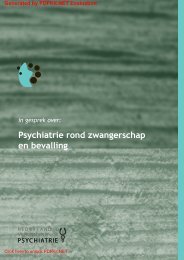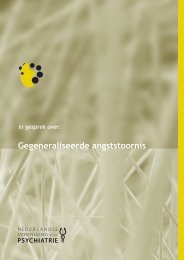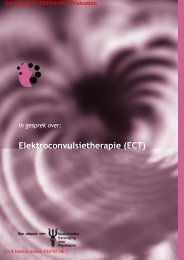Nieuwsbrief Academische Werkplaats Angst - GGZ inGeest
Nieuwsbrief Academische Werkplaats Angst - GGZ inGeest
Nieuwsbrief Academische Werkplaats Angst - GGZ inGeest
Create successful ePaper yourself
Turn your PDF publications into a flip-book with our unique Google optimized e-Paper software.
<strong>Nieuwsbrief</strong> <strong>Academische</strong> <strong>Werkplaats</strong> <strong>Angst</strong>December 2012VGCT congresMaar liefst 12 mensen van de polikliniek angst endwang bezochten op kosten van de academischewerkplaats het congres Back to Basics van deVereniging voor Gedragstherapie en CognitieveTherapie. Willemijn, Patricia, Karin & Neeltjeverzorgdenpresentaties/workshops. Patriciavan Oppen, Jenneke Wiersma &Anneke van Schaik kregen deZonMw parel uitgereikt voor hunCBASP project en Anna Muntinghwon de prijs voor de besteposter.Stand van zaken onderzoek(november 2012)Studie Onderwerp Aantaldeel-MOTARAutonomieSysteem-pilotOCSMASTERAgomelatineD-CycloserineFobieënondercontroleHardlopen vs.antidepressivaGroeps-therapievs. wachtlijstnemers6 24020 76Betrekkennaasten bijbehandeling (geencontrolegroep)4 15Terugvalpreventie:80 100afbouwmedicatie metCGT vs. afbouwmedicatieNieuw8 20antidepressivum(geencontrolegroep)“Leerpil” bij 45 60gedrags-therapievs. placeboInternet-therapie 178 244BenodigdaantalOnderzoeksnieuwsEr lopen momenteel 7 studies op de polikliniekangst. Zoals te zien zijn aanmeldingen voor destudies door jullie nog hard nodig! Op 7 januari starteen psycho-educatie cursus voor mensen met OCS.Neem voor meer informatie contact op met AnnaMuntingh.Nieuwe publicatiesBatelaan, N., Rhebergen, D., De Graaf, R., Spijker, J.,Beekman, A. & Penninx, B. (2012) Panic attacks as adimension of psychopathology: Evidence of associationswith onset and course of mental disorders and level offunctioning. J Clin Psychiatry 73:9.Batelaan,N., Smit,J., Cuijpers,P., van Marwijk,H.,Terluin,B. & van Balkom, A.J. (2012) Prevention ofanxiety disorders in primary care: A feasibility study. BMCpsychiatry, 12: 206.Scholten, W., Batelaan, N., Van Balkom, A., Penninx, W.,Smit, J. & Van Oppen, P. (2012) Recurrence of anxietydisorders and its predictors. Journal of Affective disorders,online http://dx.doi.org/10.1016/j.jad.2012.10.031Van Balkom AJ, Emmelkamp PM, Eikelenboom M,Hoogendoorn AW, Smit JH & van Oppen P. (2012)Cognitive Therapy versus Fluvoxamine as a Second-StepTreatment in Obsessive-Compulsive DisorderNonresponsive to First-Step Behavior TherapyPsychother Psychosom; 81(6):366-74.Van Balkom, A., Oosterbaan, D, Batelaan, N. Cath, D.,Hendriks, G., Van Megen, H., Schruers, K., Spijker, J. Vander Wee, N. & Van Vliet, I. (2012) De karakterisering vanangststoornissen: stageren en profileren met gezondverstand. Tijdschrift voor psychiatrie, 54, 11, p. 935-940.Veen, G., Giltay, E., Vreeburg, S., Licht, C., Cobbaert, M.,Zitman, F., Penninx, B. (2012) Determinants of salivaryevening alpha-amylase in a large sample free ofpsychopathology. Int.J.Psychophysiol. 84 (1).Versteeg, C., Bakker, A. & van Zutphen, S. (2012) Dedepressie interactiegroep. Deeltijdbehandeling depressievolgens methodiek IPT, ook in PMT en BT. (2012)Groepen, 7 (3); p. 50-55.Ideeën voor onderzoek?Heb je een klinische vraag die onderzoek behoeft, ofwil je meer betrokken raken bij onderzoeksactiviteiten?Laat het weten!
<strong>Nieuwsbrief</strong> <strong>Academische</strong> <strong>Werkplaats</strong> <strong>Angst</strong>December 2012Prevention of anxiety disorders in primary care: Afeasibility studyNeeltje M Batelaan, Jan H Smit, Pim Cuijpers, Harm WJvan Marwijk, Berend Terluin and Anton JLM van BalkomBMC Psychiatry 2012, 12:206 doi:10.1186/1471-244X-12-206BackgroundAnxiety disorders are highly prevalent in primary care andcause a substantial burden of disease. Screening on risk status,followed by preventive interventions in those at risk mayprevent the onset of anxiety disorders, and thereby reduce thedisease burden. The willingness to participate in screening andinterventions is crucial for the scope of preventive strategies,but unknown. This feasibility study, therefore, investigatedparticipation rates of screening and preventive services foranxiety disorders in primary care, and explored reasons torefrain from screening.MethodsIn three general practices, screening was offered to individualsvisiting their general practitioner (total n = 2454). To assessrisk status, a 10-item questionnaire was followed by atelephone interview (including the CIDI) when scoring above apredefined threshold. Preventive services were offered to thoseat risk. Participation rates for screening and preventive servicesfor anxiety disorders were assessed. Those not willing to bescreened were asked for their main reason to refrain fromscreening.ResultsOf all individuals, 17.3% participated in initial screening, and ofthose with a possible risk status, 56.0% continued screening. In30.1% of those assessed, a risk status to develop an anxietydisorder was verified. Of these, 22.6% already received someform of mental health treatment and 38.7% of them agreed toparticipate in a preventive intervention and were referred. Themost frequently mentioned reasons to refrain from screeningwere the emotional burden associated with elevated risk status,the assumption not to be at risk, and a lack of motivation to actupon an elevated risk status by using preventive services.ConclusionsScreening in general practice, followed by offering services toprevent anxiety disorders in those at risk did not appear to be afeasible strategy due to low participation rates. To enable thedevelopment of feasible and cost-effective preventivestrategies, exploring the reasons of low participation rates,considering involving general practitioners in preventivestrategies, and looking at preventive strategies in somatichealth care with proven feasibility may be helpful.Panic attacks as a dimension of psychopathology:evidence for associations with onset and course of mentaldisorders and level of functioning.Batelaan NM, Rhebergen D, de Graaf R, Spijker J, Beekman AT,Penninx BW.OBJECTIVE:One of the proposed revisions for DSM-5 is to rate panic attacksas a separate dimension across all mental disorders. The idea isthat panic attacks occurring outside panic disorder are adimension predicting important clinical outcomes. The aim of thisstudy was to validate the proposition for DSM-5 that panicattacks have predictive value for overall psychopathology onset,course, and functioning.METHOD:Data were derived from the Netherlands Mental Health Surveyand Incidence Study (NEMESIS), a prospective population-basedstudy. Using the Composite International Diagnostic Interview(with classifications based on DSM-III-R), 5,571 subjects wereselected who had (1) no panic history, (2) a history of panicattacks (but no panic disorder), (3) current panic attacks, or (4)current panic disorder. The impact of panic status on theprevalence of anxiety, affective, alcohol, and any mentaldisorders; on the onset and persistence of these disorders during3-year follow-up; and on levels of functioning during 3-yearfollow-up (as assessed with the 36-Item Short-Form HealthSurvey) was examined.RESULTS:Current panic attacks outside the realm of panic disorder wereassociated with increased prevalence of mental disorders (χ23 =490.6; P < .001), increased onset of mental disorders (hazardratio = 4.42; 95% CI, 2.88-6.80), persistence of mentaldisorders (odds ratio = 2.72; 95% CI, 1.53-4.82), and impairedfunctioning during 3-year follow-up (F = 69.67; P < .001).Although the impact was smaller than for panic disorder, theassociations identified for panic attacks were consistent andsignificant and were, to a lesser extent, also found for a historyof panic attacks.CONCLUSIONS:Given the consistent impact of panic attacks on various aspectsof psychopathology, the proposition to dimensionally rate panicattacks across all mental disorders may be of great value forclinical care.
<strong>Nieuwsbrief</strong> <strong>Academische</strong> <strong>Werkplaats</strong> <strong>Angst</strong>December 2012
<strong>Nieuwsbrief</strong> <strong>Academische</strong> <strong>Werkplaats</strong> <strong>Angst</strong>December 2012Int J Psychophysiol. 2012 Apr;84(1):33-8. doi:10.1016/j.ijpsycho.2012.01.005. Epub 2012 Jan 23.Determinants of salivary evening alpha-amylase in a largesample free of psychopathology.Veen G, Giltay EJ, Vreeburg SA, Licht CM, Cobbaert CM, Zitman FG,Penninx BW.SourceDepartment of Psychiatry, VU University Medical Center,Amsterdam, The Netherlands. G.Veen@ggzingeest.nlAbstractOBJECTIVE:Recently, salivary alpha-amylase (sAA) has been proposed as asuitable index for sympathetic activity and dysregulation of theautonomic nervous system (ANS). Although determinants of sAAhave been described, they have not been studied within the samestudy with a large sample size without potential disturbances ofpsychopathology. In this paper, we report about correlates ofevening sAA in saliva.METHODS:In 487 participants (mean age=42.9years, 59.8% female) withoutlifetime psychiatric disorders from the Netherlands Study ofDepression and Anxiety (NESDA), sociodemographic, health andsampling determinants of sAA levels were examined usingmultivariable linear regression analysis. sAA was measured in twosaliva samples that participants collected in the late evening, at22:00h and 23:00h, after which these were averaged.RESULTS:In multivariate analysis, age (β=0.20, p


